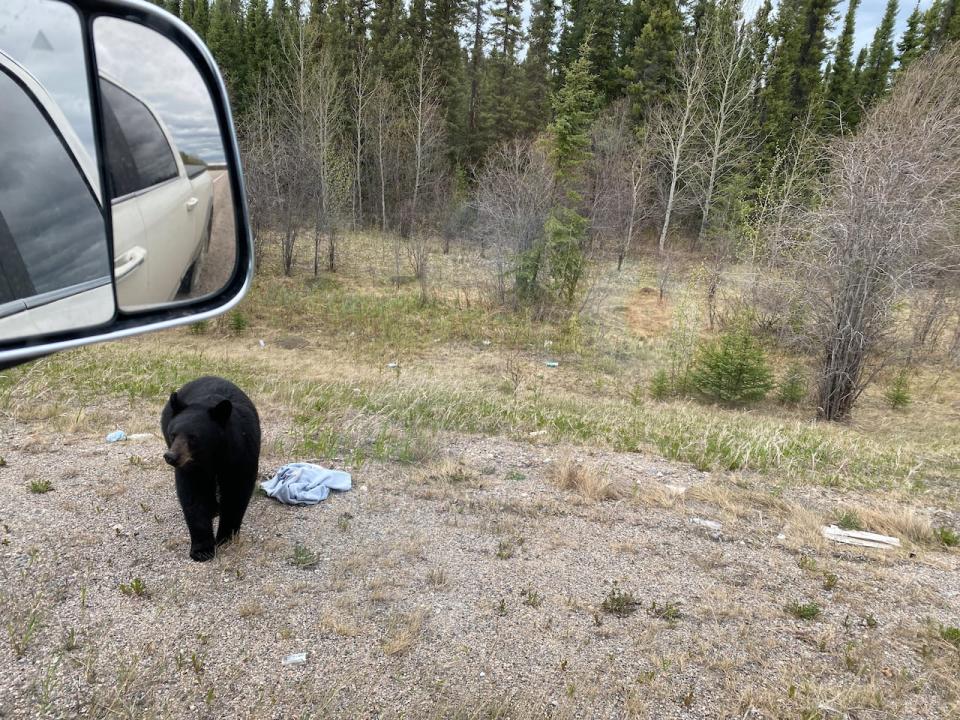Bad news for bears: accepting human food could cost the animal its life.
That’s the message Manitoba Conservation is trying to get out after a mother bear and her cubs have become habituated to being fed on the roadside along the highway, north of Thompson.
“It creates a number of hazards,” Grant White, staff sergeant with Manitoba Conservation, told CBC.
The issue of the bears approaching vehicles near the Wuskwatim turnoff on Highway 391 has been brought up on local social media sites, with residents raising concerns that the bears are becoming too familiar with human food — a concern also shared by conservation officers.
Grant White with Manitoba Conservation out on a road in Thompson. (Jenna Dulewich/CBC)
“I know people have good intentions but in the long run, it’s bad for the bears,” White said.
The hazards of fed bears include bears running onto the roads, White said. Humans might be injured in the accidents and bears could be run over or hurt in the same collision, resulting in conservation officers having to euthanize the bear.
There is also the chance the bears could attack people, White said.
“They are wild animals so they can be quite dangerous.”
Feeding wildlife along Manitoba roads and highways is also illegal under the provincial Wildlife Act.
Anyone found guilty of offences in the act can be subject to a fine up to $25,000 or up to six months in jail.
There are no plans for the bears north of Thompson at this time, White said, noting that if people quit feeding them, they will eventually move on and be self-sufficient in the forest.

A black bear north of Thompson strolls along Highway 391. (Jenna Dulewich/CBC)
Fed bears along the highway are “not overly common” in the north, White said, but officers have seen problems on Highway 391 — the road that leads to the end of the roads in the north — and also on the highway to Norway House and Cross Lake.
“I think people are wanting to help the bears, especially the cubs. They probably want to help feed mom so she can help raise her young ones,” White said, noting bears are self-sufficient in the wild with a diet of plants, berries, grass, nuts, eggs, bees and fish.
But bears are opportunists and will find whatever meal is easiest, and once bears start being fed by humans, they become used to the diet and return to the same spots.
Trapping bears is tricky
One option for fed bears is relocation, White said. Officers can trap the bears and move them far away, but that typically only has a good success rate for cubs between two to four years old. Adult bears often come right back to the same spot.
It is also tricky to trap a mother bear with her cubs, White said, because if the whole family is not caught in the bear trap the officers could be dealing with a very upset mommy bear.
Another reason people might feed bears roadside is for photos, White said, but people can get the pictures without endangering themselves or the animals.
“If people are pulling over the side of the road and putting their hazards on … they’re being safe that way. Take your picture and move on,” White said.
If people want to help bears, White said they can donate to different wildlife organizations such as Ducks Unlimited or the Nature Conservancy of Canada, or people can simply take care of their own backyard.
“Everybody wants to help wildlife and there’s better ways of doing it. You could keep our forests clean, keep things cleaned up alongside the road … and that’s where I would recommend spending my time instead of feeding them off the road.”
Signup bonus from





